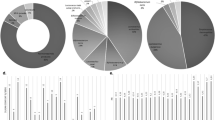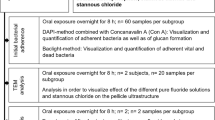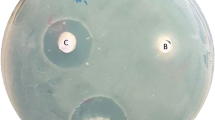Abstract
Objective:
This in vitro study compared the adhesion of two probiotics microorganisms (Lactobacillus casei Shirota and Lactobacillus acidophilus) to an artificial caries model.
Method:
In total, 30 bovine teeth were longitudinally sectioned, excluding the lingual half surface. The specimens were covered with nail varnish, except for an area of 3 by 5 mm in dentin, suspended in an artificial caries solution promoted by Streptococcus mutans, and incubated at 37°C. After 14 days, the specimens were separated equally into two groups and transferred to a brain heart infusion culture media containing L. acidophilus (group A) and L. casei Shirota (group S), at 37°C. After 48 h, the exposed area of dentin was washed with 1 ml of distilled water and the caries dentin was removed and dispersed in 1 ml of saline solution. The samples of distilled water and caries dentin were diluted and inoculated in Rogosa selective Lactobacillus agar. The results in CFU/ml were analysed by the Mann–Whitney test.
Results:
There was no significant difference between Groups A and S for the lactobacilli count in samples of distilled water (P=0.237).
Conclusions:
The amount of L. acidophilus in the artificially caries dentin was significantly superior compared to L. casei Shirota (P=0.047), suggesting an inferior adhesion potential for this microorganism.
This is a preview of subscription content, access via your institution
Access options
Subscribe to this journal
Receive 12 print issues and online access
$259.00 per year
only $21.58 per issue
Buy this article
- Purchase on Springer Link
- Instant access to full article PDF
Prices may be subject to local taxes which are calculated during checkout
Similar content being viewed by others
References
Busscher HJ, Free RH, van Weissenbruch R, Albers FWJ & van der Mei HC (2000): Preliminary observations on influence of dairy products on biofilm removal from silicone rubber voice prostheses in vitro. J. Dairy Sci. 83, 641–647.
Busscher HJ, Mulder AFJM & van der Mei HC (1999): In vitro adhesion to enamel and in vivo colonization of tooth surfaces by lactobacilli from a bio-yoghurt. Caries Res. 33, 403–404.
Edwardson S (1974): Bacteriological studies on deep areas of carious dentine. Odontol. Rev. (Suppl. 32), 1–143.
Gomes AMP & Malcata FX (1999): Agentes probióticos em alimentos: aspectos fisiológicos e terapêuticos, e aplicações tecnológicas. Boletim Biotecnol. 64, 12–22.
Havenaar R & Huis In’t Veld JHJ (1992): Probiotics: a general review. In The Lactic Acid Bacteria in Health and Disease ed. BJB Wood, pp 151–170. London: Elsevier Applied Science.
Jay P (1947): The reduction of Lactobacillus acidophilus counts by the periodic restriction of carbohydrates. Am. J. Orthod. Oral Surg. 33, 162–172.
Klein U, Kanellis MJ & Drake D (1999): Effects of four anticaries agents on lesion depth progression in an in vitro caries model. Pediatr. Dent. 21, 176–180.
Loesche WJ (1994): Ecology of the oral flora. In Oral Microbiology and Immunology : eds RJ Nisengard & MG Newman, pp 307–319. Philadelphia: WB Saunders Company.
Maltz M, Oliveira EF, Fontanella V & Bianche R (2002): A clinical, microbiologic, and radiografic study of deep caries lesions after incomplete caries removal. Quintessence Int. 33, 151–159.
Marteau P & Rambaud JC (1993): Potential of using lactic acid bacteria for therapy and immunomodulation in man. FEMS Microbiol. Rev. 12, 207–220.
Milnes AR & Bowden GH (1985): The microflora associated with the developing lesions of nursing caries. Caries Res. 19, 289–297.
Nagao F, Nakayama M, Muto T & Okumura K (2000): Effects of a fermented milk drink containing Lactobacillus casei strain Shirota on the immune system in healthy human subjects. Biosci. Biotechnol. Biochem. 64, 2706–2708.
Rogosa M, Mitchell JA & Wiseman RF (1951): A selective medium for the isolation and enumeration of oral lactobacilli. J. Dent. Res. 30, 682–689.
Spanhaak S, Havenaar R & Schaafsma G (1998): The effect of consumption of milk fermented by Lactobacillus casei strain Shirota on the intestinal microflora and immune parameters in humans. Eur. J. Clin. Nutr. 52, 899–907.
Yaeshima T (1996): Bebefits of bifidobacteria to human health. Bull. Int. Dairy Fed. 313, 36–42.
Yuki N, Watanabe K, Mike A, Tagami Y, Tanaka R, Ohwaki M & Morotomi M (1999): Survival of a probiotic, Lactobacillus casei strain Shirota, in the gastrointestinal tract: selective isolation from faeces and identification using monoclonal antibodies. Int. J. Food Microbiol. 48, 51–57.
Author information
Authors and Affiliations
Corresponding author
Rights and permissions
About this article
Cite this article
Lima, L., Motisuki, C., Madalena Palomari Spolidorio, D. et al. In vitro evaluation of probiotics microorganisms adhesion to an artificial caries model. Eur J Clin Nutr 59, 884–886 (2005). https://doi.org/10.1038/sj.ejcn.1602158
Received:
Accepted:
Published:
Issue Date:
DOI: https://doi.org/10.1038/sj.ejcn.1602158
Keywords
This article is cited by
-
Effect of lactobacillus reuteri-derived probiotic nano-formulation on recurrent aphthous stomatitis: a double-blinded randomized clinical trial
BMC Oral Health (2023)
-
Effect of cetrimide 2% with and without photodynamic therapy to reduce Streptococcus mutans burden in dentinal carious lesions
Lasers in Medical Science (2021)
-
Probiotic Lactobacillus paracasei effect on cariogenic bacterial flora
Clinical Oral Investigations (2011)



